The game is very simple. There is a bag of jewels. 23 of the jewels are unmarked, 9 of the jewels have a sad-face on them, and 1 jewel has a star. Each player takes their turn taking one jewel at a time out of the jewel bag without looking. If the player obtains an unmarked jewel, they have a choice... place the jewel into your treasure chest, ending your turn and ensuring you keep the jewel, or grab another jewel from the bag. You can repeat this process as many times as you want in one turn, but once you pull out a sad-face jewel, all jewels you obtained that turn go back into the bag. If you get the star, the next jewel you pull is a 'free-pass', so even if you pull a sad-face, you can keep your jewels.
So the strategy in the game is balancing risk versus reward and trying to accumulate a critical amount of jewels to give you the win (which is 8 jewels if you are playing with 3 people).
Unmarked, sad-face and star jewels. We like to call the sad-faces "Frownies".
After playing with Ryan and Emily quite a few times, I've made some observations. Ryan goes for glory every time... he doesn't stop until he gets at least 4 in a turn, and sometimes goes for it beyond that. In contrast, Emily can't seem to bear the disappointment of having jewels pulled from her hands and will be happy to stop after 1 jewel. And I guess my approach lands somewhere in the middle... with a little more aggression when the games starts and the unmarked to sad-face ratio is higher, and then playing conservative toward the end.
So with a name like "Don't Be Greedy", Emily has to be in good shape... right? And Ryan is on crash-course for surefire disappointment... right? My experience so far doesn't line up. Ryan has won a convincing majority of the games we have played (and reminds us of this regularly). Ryan's success made me start to wonder whether this game was actually won more often by playing agressive... by being greedy.
Nerding Out
I set out to determine whether there was an advantage to drawing more or less per turn. To do this, I created a simulation of the game in R. I simplified the game a bit by requiring each person to always draw the same amount of jewels per turn no matter the game status (unless someone gets the star on their last turn, in which they get the 'free-pass' and then stop). This simplification distances the simulation from reality a little bit, but not too much considering I'm playing with a 3 year old and 5 year old who seem to have their mind set on a desired amount to draw. I set the game up as a function with variables for how many cards each player would draw and what the win-condition is.
I'm a R novice, so I'm sure this could all be done with one line of code and/or way more efficiently. The function outputs what player won, and I convert that to how many cards that person drew outside the function.
I simulated 10 million games of Don't Be Greedy, with each player being randomly assigned a required draw amount between 1 and 8 jewels. Out of the 10 million games played, I tallied up the wins for each required draw amount and plotted them in terms of their overall win percentage. (I also confirmed the distribution of required draw amounts was uniform from 1 to 8... not shown).
The results show that Emily's strategy of staying at 1 isn't going to fare to well. The maximum success rate is at 3 draws per turn, which I guess is still on the side of not being greedy. But there sure isn't much of a penalty for getting reasonably greedy.. there's very little drop off in success rate for 4, 5 and 6 draws per turn. Ryan's strategy for winning seems to have some legitimacy.
I confirmed that this trend doesn't change if a game was constructed where only conservative people were invited (i.e. eliminate people who always draw 6, 7 or 8 times)
Be A Little Greedy
"Don't Be Greedy" could be justified as the name of the game... most people wouldn't consider going for 2 or 3 as being greedy, and this gives you the best chance at winning. But I would propose the following as more accurate names for the game:
Don't Get Too Greedy
Probably a bit more accurate of a name. Still a good life lesson.
Definitely Don't Be Too Conservative
A good life lesson. No one ever gets anywhere without taking a small amount of risk.
One More Probably Won't Hurt You
My college slogan. And generally not great advise.
Regardless of what it's called, it's a really fun game that the kids love. And now you know the best ways to win (if you decide you can only draw the same amount of times every turn).
Let me know if you have other names or if you have other suggestions for things to add.



